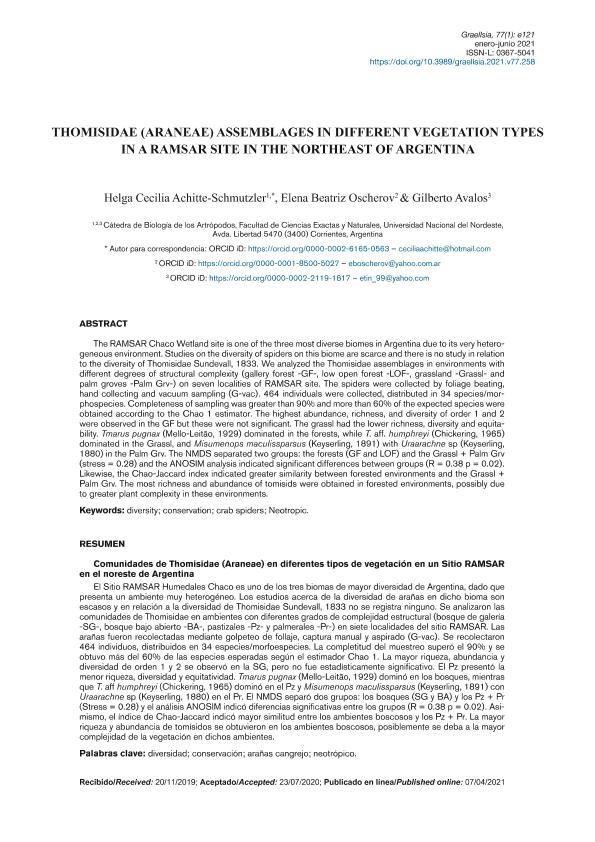Mostrar el registro sencillo del ítem
dc.contributor.author
Achitte Schmutzler, Helga Cecilia

dc.contributor.author
Oscherov, Elena Beatriz

dc.contributor.author
Avalos, Gilberto

dc.date.available
2022-02-01T17:32:00Z
dc.date.issued
2021-04
dc.identifier.citation
Achitte Schmutzler, Helga Cecilia; Oscherov, Elena Beatriz; Avalos, Gilberto; Thomisidae (Araneae) assemblages in different vegetation types in a ramsar site in the northeast of Argentina
; Consejo Superior de Investigaciones Científicas; Graellsia; 77; 1; 4-2021; 1-12
dc.identifier.issn
0367-5041
dc.identifier.uri
http://hdl.handle.net/11336/151090
dc.description.abstract
El Sitio RAMSAR Humedales Chaco es uno de los tres biomas de mayor diversidad de Argentina, dado que presenta un ambiente muy heterogéneo. Los estudios acerca de la diversidad de arañas en dicho bioma son escasos y en relación a la diversidad de Thomisidae Sundevall, 1833 no se registra ninguno. Se analizaron las comunidades de Thomisidae en ambientes con diferentes grados de complejidad estructural (bosque de galería -SG-, bosque bajo abierto -BA-, pastizales -Pz- y palmerales -Pr-) en siete localidades del sitio RAMSAR. Lasarañas fueron recolectadas mediante golpeteo de follaje, captura manual y aspirado (G-vac). Se recolectaron464 individuos, distribuidos en 34 especies/morfoespecies. La completitud del muestreo superó el 90% y seobtuvo más del 60% de las especies esperadas según el estimador Chao 1. La mayor riqueza, abundancia ydiversidad de orden 1 y 2 se observó en la SG, pero no fue estadísticamente significativo. El Pz presentó lamenor riqueza, diversidad y equitatividad. Tmarus pugnax (Mello-Leitão, 1929) dominó en los bosques, mientrasque T. aff humphreyi (Chickering, 1965) dominó en el Pz y Misumenops maculissparsus (Keyserling, 1891) conUraarachne sp(Keyserling, 1880)en el Pr. El NMDS separó dos grupos: los bosques (SG y BA) y los Pz + Pr(Stress = 0.28) y el análisis ANOSIM indicó diferencias significativas entre los grupos (R = 0.38 p = 0.02). Asi-mismo, el índice de Chao-Jaccard indicó mayor similitud entre los ambientes boscosos y los Pz + Pr. La mayorriqueza y abundancia de tomísidos se obtuvieron en los ambientes boscosos, posiblemente se deba a la mayorcomplejidad de la vegetación en dichos ambientes.
dc.description.abstract
The RAMSAR Chaco Wetland site is one of the three most diverse biomes in Argentina due to its very hetero-geneous environment. Studies on the diversity of spiders on this biome are scarce and there is no study in relation to the diversity of Thomisidae Sundevall, 1833. We analyzed the Thomisidae assemblages in environments with different degrees of structural complexity (gallery forest -GF-, low open forest -LOF-, grassland -Grassl- and palm groves -Palm Grv-) on seven localities of RAMSAR site. The spiders were collected by foliage beating, hand collecting and vacuum sampling (G-vac). 464 individuals were collected, distributed in 34 species/mor-phospecies. Completeness of sampling was greater than 90% and more than 60% of the expected species were obtained according to the Chao 1 estimator. The highest abundance, richness, and diversity of order 1 and 2 were observed in the GF but these were not significant. The grassl had the lower richness, diversity and equita-bility.Tmarus pugnax (Mello-Leitão, 1929)dominated in the forests, while T. aff. humphreyi (Chickering, 1965)dominated in the Grassl, and Misumenops maculissparsus (Keyserling, 1891) with Uraarachne sp (Keyserling, 1880)in the Palm Grv. The NMDS separated two groups: the forests (GF and LOF) and the Grassl + Palm Grv (stress = 0.28) and the ANOSIM analysis indicated significant differences between groups (R = 0.38 p = 0.02). Likewise, the Chao-Jaccard index indicated greater similarity between forested environments and the Grassl + Palm Grv. The most richness and abundance of tomisids were obtained in forested environments, possibly due to greater plant complexity in these environments.
dc.format
application/pdf
dc.language.iso
eng
dc.publisher
Consejo Superior de Investigaciones Científicas

dc.rights
info:eu-repo/semantics/openAccess
dc.rights.uri
https://creativecommons.org/licenses/by/2.5/ar/
dc.subject
CONSERVATION
dc.subject
CRAB SPIDERS
dc.subject
DIVERSITY
dc.subject
NEOTROPIC
dc.subject.classification
Ecología

dc.subject.classification
Ciencias Biológicas

dc.subject.classification
CIENCIAS NATURALES Y EXACTAS

dc.title
Thomisidae (Araneae) assemblages in different vegetation types in a ramsar site in the northeast of Argentina
dc.title
Comunidades de thomisidae (Araneae) en diferentes tipos de vegetación en un sitio ramsar en el noreste de Argentina
dc.type
info:eu-repo/semantics/article
dc.type
info:ar-repo/semantics/artículo
dc.type
info:eu-repo/semantics/publishedVersion
dc.date.updated
2022-01-06T14:54:23Z
dc.identifier.eissn
1989-953X
dc.journal.volume
77
dc.journal.number
1
dc.journal.pagination
1-12
dc.journal.pais
España

dc.description.fil
Fil: Achitte Schmutzler, Helga Cecilia. Universidad Nacional del Nordeste. Facultad de Ciencias Exactas, Naturales y Agrimensura. Laboratorio de Biología de los Artrópodos; Argentina. Consejo Nacional de Investigaciones Científicas y Técnicas. Centro Científico Tecnológico Conicet - Nordeste; Argentina
dc.description.fil
Fil: Oscherov, Elena Beatriz. Universidad Nacional del Nordeste. Facultad de Ciencias Exactas, Naturales y Agrimensura. Laboratorio de Biología de los Artrópodos; Argentina
dc.description.fil
Fil: Avalos, Gilberto. Universidad Nacional del Nordeste. Facultad de Ciencias Exactas, Naturales y Agrimensura. Laboratorio de Biología de los Artrópodos; Argentina
dc.journal.title
Graellsia
dc.relation.alternativeid
info:eu-repo/semantics/altIdentifier/url/https://graellsia.revistas.csic.es/index.php/graellsia/article/view/637
dc.relation.alternativeid
info:eu-repo/semantics/altIdentifier/doi/http://dx.doi.org/10.3989/graellsia.2021.v77.258
Archivos asociados
